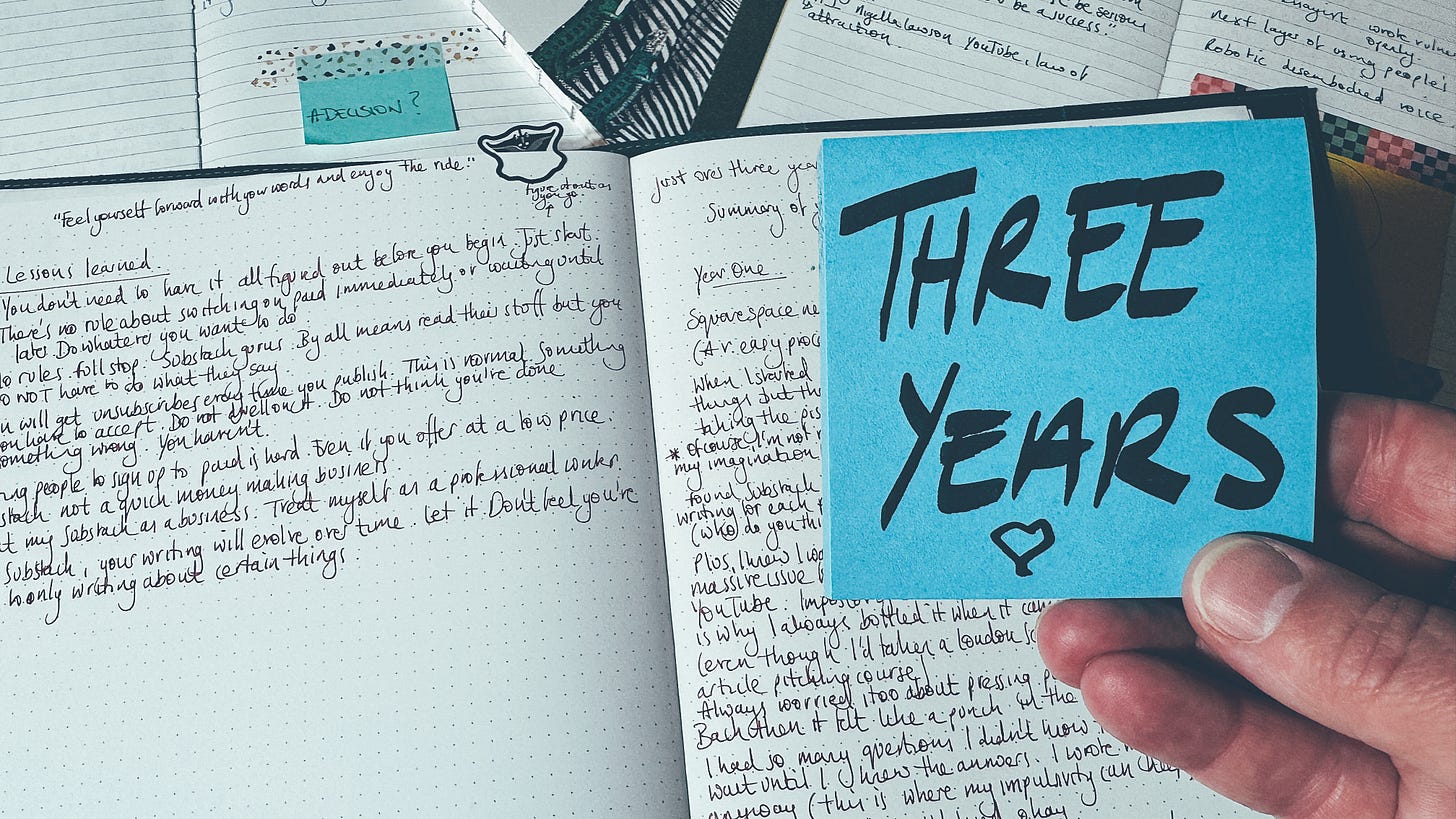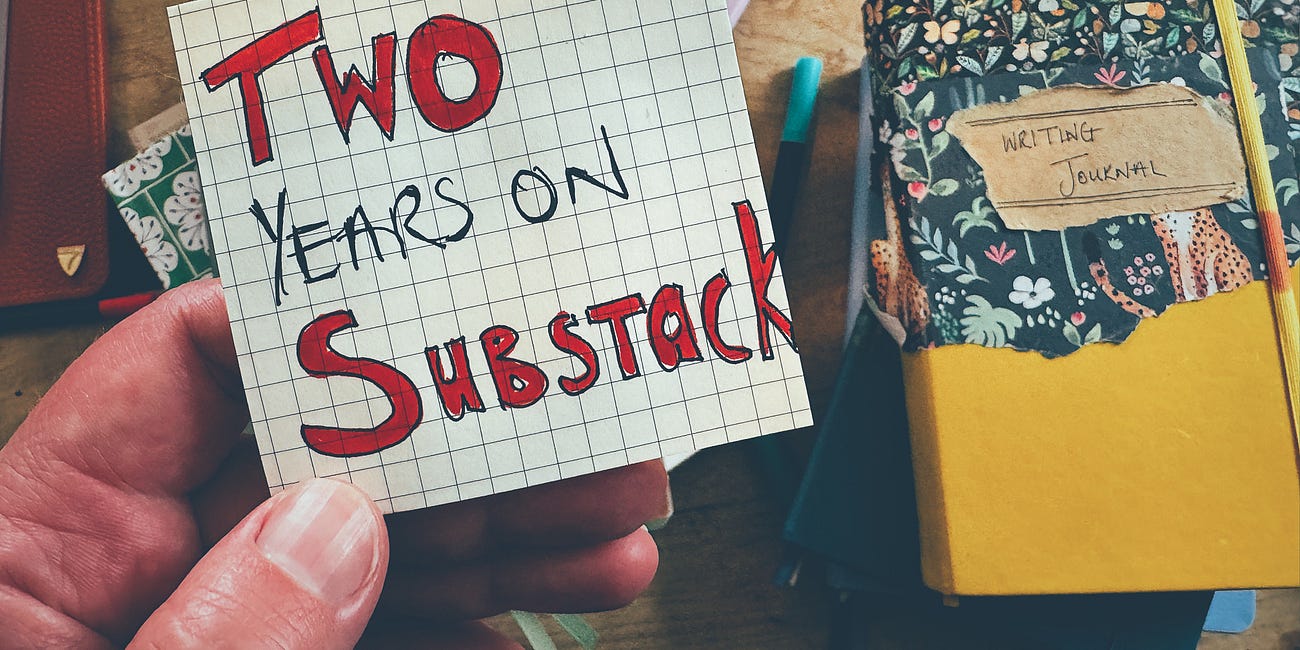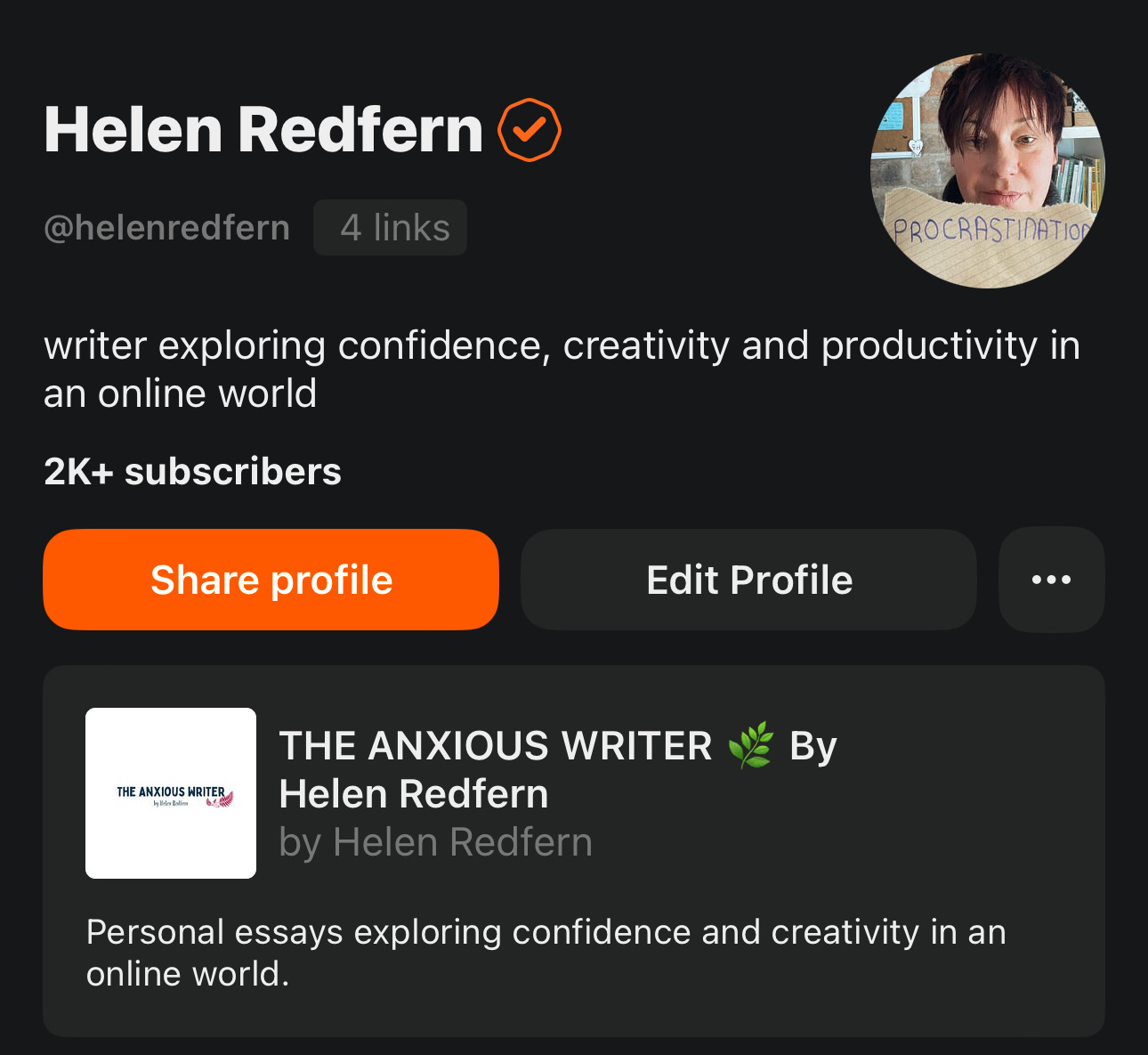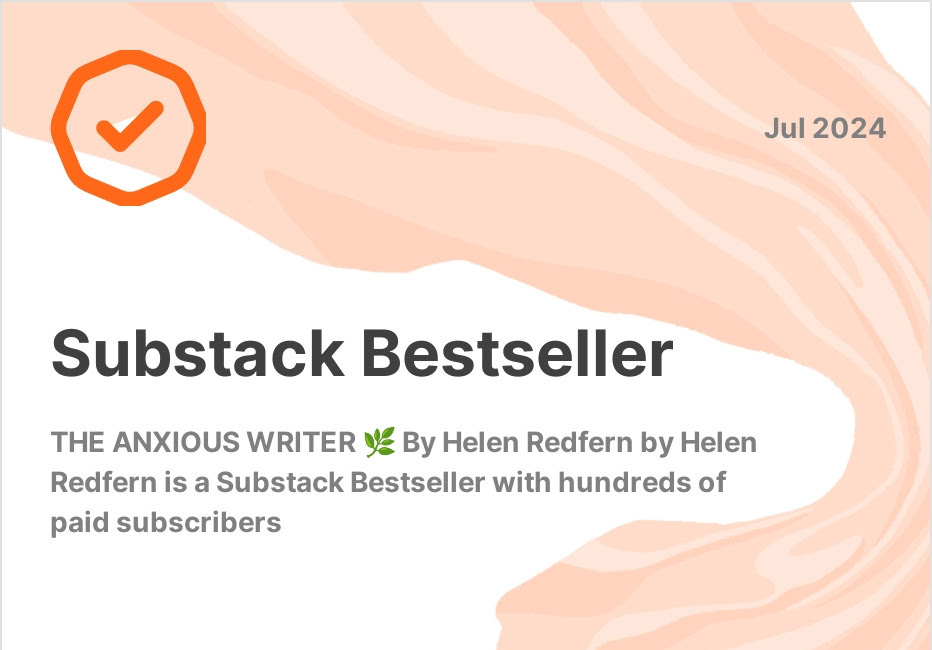It’s been just over three years since I began writing on the Substack platform. I started with around 900 subscribers from my Squarespace-hosted newsletter, called Desk Stories. This original list was built thanks to my platform on Instagram, which, at its peak, had nearly 20,000 followers.
When I started my original newsletter, I was in a completely different place from where I am now. I lacked a lot of confidence, a huge amount in fact, I had massive fears: failure, success and my school friends taking the piss. I mean, I’m going to be fifty in October for God’s sake, but my fears had taken on the image of faceless, mocking school friends. Terrifying teenagers, if you like, who would laugh, sneer and deride my efforts. I would start lots of projects but never finish them. Two novels, partially written, were sitting on my hard drive, alongside ideas for a chicken-keeping memoir, an outline for a non-fiction book and other various pieces of writing.
I also had a huge amount of impostor syndrome around a few issues but predominantly around charging for my words, as I discovered when I began my Patreon (I want to say around 2017/18). On this platform, I stated that I’d write an essay about creativity and confidence once a month. Subscribers paid one to two dollars a month to read it. But, I had it set up so it only charged people once the essay had been published. Which meant I wouldn’t write the monthly essay, as I felt bad about charging people for my work. (A very persuasive voice in my head was saying, your writing isn’t worth $1 per essay.) Eventually, I changed the back-end so it charged once a month rather than by every essay, which forced me to write every four weeks, otherwise my subscribers would be paying for fresh air.
I’ve been writing on a blog in various guises for nineteen years. I’ve also written on literary blogs as a columnist, alongside writing for The Huffington Post. Plus, my words have been printed in physical magazines and a couple of indie-published books by a collective of writers. And I’d also experimented with the Medium platform.
Despite all of this in my background, transferring to Substack made me feel all the emotions. It actually took me an entire year from signing up to the platform to writing my first piece. When I eventually pressed publish on my first piece, my legs were trembling like my dog’s legs do at the vets, my heart was racing: jumping from my mouth to my stomach in quick succession, and it was all I could think about: wondering how many had read it, what they were thinking, whether they’d think I was a nob and how many would unsubscribe. (And yes, some did unsubscribe. Which was gutting. But I carried on.)
The advice at the time was to build up your subscribers before launching the paid element. Not one to live by creative ‘rules’, I turned paid on immediately because otherwise I knew I would have low-level anxiety about doing it ‘one day in the future’. I did it because then it was done. Three years later, I have no regrets about that at all. In fact, I think it helped me get over the whole, my writing isn’t worth paying for issue that I had. (Although, even now, that thought pops back now and again.)
One of the best things I did for myself in that first year (once I finally started) was to jump in head first, without overthinking (too much!) about all the doubts and negativity I had in my head. That impulsivity enabled me to discover who I was as a writer. I know lots of people think that ‘one day’ they’ll take the leap and start writing on Substack. But they think they have to be better at writing, or have a niche that they focus on, or be more of an expert. The truth is, none of them is true. You start and get better by writing and publishing. Then write more and publish more. There’s no magic formula. No rules you have to adhere to. Just write and publish. Write and publish.
You can read more about my first anniversary on Substack here.
Anniversary Essay: One Year of Behind-the-Scenes from My Substack
To celebrate Substack mentioning this essay in one of their recent emails, I’m unlocking this one year anniversary essay for twenty-four hours.
My second year on Substack was harder. My burnout had returned. I was tutoring someone in real life, and it brought back some of my burnout symptoms. Plus I lost what it was I was writing. Because at some point over that year, I lost myself. But I did keep going. Having paid subscribers does force you to keep writing (which can be a good and a bad thing), and I came through the other side.
I learned lots of lessons, which have supported me during my third year. I now take more time off, I don’t feel (as) guilty for sitting and reading all day if I need/want to. I make sure I refill my creative well by going to musical events, plays and other outings. I spend time with the few amazing friends I have who truly get and support me. And I also learned in that second year that it’s okay to make changes. My Substack made a shift during that second year, and it’s also shifted again in the third year.
You can read more about my second anniversary here.
Anniversary Essay: Two Years of Behind-the-Scenes from My Substack
It has been two years since I’ve been writing my Substack newsletter so I should be a bit of a pro at it by now. But the truth is, I took my eye off the ball for a bit and sometimes it feels like I’m…
My third year
During the second month of my third year, I got a checkmark added to my name on my Substack profile. An orange circle with an orange tick inside.
This meant I was now a Substack bestseller. And I know people say not to focus on the numbers as it’ll drive you insane, but this was a huge moment for me. I’ve never EVER been given a tick on any platform. I’ve certainly never been called a bestseller before.
But what this tick meant, more than anything else, is that I had faith in myself to start. And I kept going through two lots of burnout, through some tough moments, through perimenopause induced anxiety and depression, through a period of devastating loneliness. I turned up consistently. I wrote and I published.
AND I DIDN’T GIVE UP ON THE PROJECT LIKE I’VE DONE SO MANY TIMES IN THE PAST.
You can read more about that orange tick moment here:
So, this happened...
It’s still sinking in. A few days ago I received an email invitation to join a group called Substack Bestsellers. And I thought, what the flip, is this a scam?! With trepidation I ignored that pessim…
I’m sure this then went on to give me the confidence to finally finish my non-fiction book proposal and to start submitting it to agents. It’s had a huge knock-on effect. (And now I’m working on my novel, too. This is huge.)
During this year, I also had the confidence to say, this isn’t working. Such as the non-fiction book club and the live workshops and masterclasses I was planning on doing at the time. I love doing the book club and the live events, but I just didn’t have it in me. Instead of beating myself up or continuing and exhausting myself, I made practical changes. And the sky didn’t fall in.
The burnout was still hitting hard in the second half of the 2024 and I wrote a piece called Can I Write My Way Out of Burnout? And I tell you what, this piece was pivotal for me. Big. Huge. The response I got from you, my readers, was brilliant. Suggestions, reassurance, talking me down…I am so grateful. Which is why it’s so important to recognise that you have a community of real-life people reading your words. They’re not just numbers. They’re people with experience and knowledge. With good ideas and calming words. And they (I keep saying ‘they’ but obviously I mean ‘you’) keep reading not because of the topics necessarily. But because of my writing voice.
Which is why it is so important to develop your writing voice. You can write really clever things here on Substack, but if your personality doesn’t gel with readers (and we’re not going to appeal to everyone), then people won’t stick around. And the best way to develop your writing voice? By writing. And publishing. And writing and publishing. I’m sure I’ve already said this :)
Some of the answers to the ‘can I write my way out of burnout’ essay made me really pause for thought. I realised I could write about different topics. Or try slightly different types of essays. I wrote about my chickens, I started writing about Agatha Christie, I allowed myself to be more vulnerable in my piece called What If She Turns Out Like Me?.
Then another pivotal moment occurred. Again, from a reader comment. (Seriously, community is everything.) Linda wrote this comment on one of my essays:
I hear and identify with your fears - and procrastination. It is a painful place to be. I mentioned to a friend that I was following "The Anxious Writer". She suggested that naming oneself as anxious keeps a person stuck in that label. I tried to rationalise that you'd only used that title to attract readers to your Substack but she wasn't buying any of it! She continued to declare that words matter; how we name ourselves determines the outcome. Does this resonate at all with you?!! It did with me, and I'm rethinking how I categorise myself.
This comment was the encouragement I needed to change the name of my Substack newsletter from The Anxious Writer to Brave Words. And also to unapologetically allow myself to write about those things that truly interest me and encourage me down research rabbit holes.
You can read more about it in this piece below:
Soon after, I wrote a piece called Agatha Christie and The Mystery of the Blue Train. A piece I never would have had the capacity for or the confidence to write in my first two years. And this led to an opinion-type piece on Agatha Christie and Ai.
I love writing essays like these. LOVE it. And I’m looking forward to writing more like this in the future (once I’ve had my summer rest). They fill me with joy, push me out of my comfort zone and just make me a happy and fulfilled writer.
Finally, I designed a questionnaire, and the results from that directly led to me creating my junk journal diary series. Which, again, I just LOVE doing.
The biggest lessons I learned from my third year are therefore:
Keep writing and publishing. This enables you to improve as a writer. To come up with more ideas. To discover what you love to write about. This only comes about by taking action.
Listen to your community. They are incredibly wise.
Don’t be afraid to drop things if they aren’t working for you or your audience.
Don’t be afraid to experiment. And don’t be scared to fail.
Allow yourself to pivot. Don’t feel that your audience won’t like it. Most of your audience is here because of you and will read anything you write.
Change the name of your newsletter if you don’t feel it’s working or reflecting who you are and what you write about. (Incidentally, I’ve changed the name of my newsletter three or four times, but my domain is always my name, helenredfern.substack.com).
Statistics
On 17th June 2022, I imported 945 subscribers from my original newsletter, Desk Stories.
On 7th June 2023, I had 1482 subscribers and 61 paid (consisting of 53 actual paid, 6 comps and 2 gifted). In year one, I grew by 537 subscribers.
On 7th June 2024, I had 2442 subscribers and 110 paid (consisting of 93 actual paid, 16 comps and 1 gift). To be a bestseller, you need 100 paid subscribers; it doesn’t include comps or gifted. In year two, I grew by 960 subscribers.
On 23rd June 2025, I had 5020 followers (this is a newer statistic thanks to Substack Notes), 3146 subscribers, and 143 paid (with 12 of them being comps). In year three, I grew by 704 subscribers.
Substack is not a get-rich-quick scheme. It doesn’t grow overnight. But it is a place to discover yourself as a writer. To experiment, to grow a platform and community, and to push yourself out of your comfort zone.
I’ve loved my three years here. And I’m really excited for this, my fourth year and the additions I’m working on, like the masterclass called Becoming Creatively Confident, which I’m hoping to do live for paid subscribers towards the end of August.
To join the paid subscriber community you can do so by clicking on the button below. You’ll receive all the behind-the-scenes essays, introspective, honest and vulnerable essays about my creative process or my writing journey, the writing notebook masterclass and future masterclasses starting in August.
It is currently just £20 for an entire year.











Thank you Helen, this came at the very best time to hear these encouraging confirming words. From my appreciative heart to your generous and bold heart, A.T.
Congrats, Helen! Keep being your authentic self and we’ll definitely keep reading!